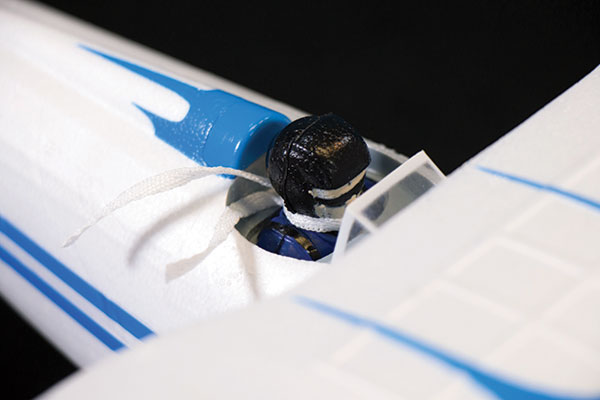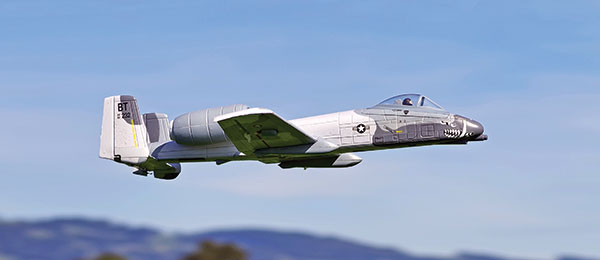
Written by Jay Smith An enjoyable and capable micro barnstormer Product review As seen in the Winter 2018 issue of Park Pilot.
Specifications:
Type: Ultra micro sport scale Wingspan: 21.7 inches Wing area: 132 square inches Length: 16.5 inches Needed to complete: Four-plus-channel DSM2/DSMX transmitter; two-cell 200 to 280 mAh LiPo battery Minimum flying area: Sports field Power system: 3,000 Kv outrunner brushless motor (included); 5.75 x 2.50 propeller (included); E-flite 2S 280 mAh 30C LiPo battery Flying weight: 3.5 ounces Flight time: 6-plus minutes Price: $129.99 Info: e-fliterc.comFeatures:
>> Impressive scale looks >> Brushless power system >> AS3X stabilization technology >> Scale landing gear with wheel pants and a steerable tail wheelProduct Review
>> The WACO Aircraft Company, located in Troy, Ohio, produced a wide range of biplanes from 1920 to 1947. The company is said to have taken its name from a flying field and anyone with interest in open cockpit biplanes is likely to be familiar with them. The E-flite UMX Waco BL is the classic style of the biplane with pilot-pleasing details including molded surface detailing on the wing and fuselage, carbon-fiber flying wires, windscreens, and a pilot figure complete with a flying scarf.
The E-flite UMX Waco BL is as enjoyable to look at as it is to fly. Horizon Hobby packed many scale details into this small aircraft.
The brushless power system provides ample power to allow for a full repertoire of barnstormer aerobatics, and onboard AS3X stabilization smooths things out in higher wind conditions. The biplane also has a generous wing area—allowing for enjoyable slow flight that provides an opportunity to appreciate its scale accoutrements while making touch-and-gos or photo passes. The aircraft requires a four-plus-channel DSM2/DSMX transmitter for guidance. The instructions to bind the model are clearly stated in the manual with the aircraft. You will also need to supply a two-cell 200 to 280 mAh LiPo battery and charger. Spektrum offers the transmitter setup file for the Waco on the Spektrum website. This allowed me to download the file to the transmitter’s SD card and then import it into the radio. By doing so, the model naming and dual rates were already done. You should still test the aircraft to confirm that all of the surfaces are moving in the proper direction and the dual rates work as expected.

A pilot figure with a scarf and clear windscreens are two of the many details incorporated into the Waco.
It is likely that most readers have had experience with an AS3X-equipped aircraft, but if you haven’t, be sure to follow the instructions in the manual. You must advance the throttle above 25% to activate the AS3X system. When active and with the throttle at zero, move the entire aircraft as shown in the manual to ensure that the control surfaces move in the correct direction. If any of the flight surfaces are not centered when the aircraft is powered and ready for flight and the transmitter trims and sub-trims are set to zero, use a pair of pliers to carefully bend the U-shape metal linkage. This should be done instead of using trim or sub-trim and will provide the best results from the AS3X system. The only adjustment I had to make was to the rudder. I followed the manual’s recommendation for the center of gravity, which is measured at 40mm from the leading edge of the top wing, where the wing meets the fuselage. The battery hatch is located in the top of the cowl and held in place by magnets. This makes battery changes easy.

The battery hatch is cleverly disguised as part of the cowling and is held on with magnets.
I also set up a throttle cut on my DX9 transmitter so that the throttle can’t be bumped while I am connecting the battery and am in reach of the model’s propeller. The first flight was made with low rates and the Waco pointed directly into the wind. With scale models, I prefer to ease into the throttle and execute a scale takeoff. Still, the model was airborne in a few feet. Minor trim adjustments to the elevator had the Waco flying well.

Both top and bottom wings are equipped with ailerons and they provide a nice roll rate.
The Waco benefits from coordinated turns using rudder and is capable of slow flight thanks to its generous wing area. The power system is a perfect match for the aircraft—allowing for barnstormer-type aerobatics and having enough power to get you out of trouble. All of the basic aerobatics were done on both low and high rates, and rolls definitely look much better with the extra throw. The model can loop consecutively and its loops are very small with full up-elevator. Thanks to the AS3X stabilization system, the Waco doesn’t have any bad habits if you stall it, and the model has a reasonable glide. So far, all of my flights have been made from a hard surface. Given the model’s wheel pants, grass landings could be challenging.

The UMX Waco BL comes with nicely molded foam wheel pants.
The Waco is a fantastic, small model with a nice number of scale details right out of the box. It flies well and has a nicely matched power system. The 2S 280 mAh LiPo battery easily provides 6-plus minutes of mixed flying. It is so enjoyable to fly that you will definitely want to have a few batteries on hand! -Jay Smith [email protected]
Article:





